Advances in Distal-Scanning Two-Photon Endomicroscopy for Biomedical Imaging
Abstract
1. Introduction
2. Classifications of Distal-Scanning 2PEM
3. Research Progress in Distal-Scanning 2PEM
3.1. PZT-Based Common-Path 2PEM
3.2. PZT-Based Separate-Path 2PEM
3.3. MEMS-Based Common-Path 2PEM
3.4. MEMS-Based Separate-Path 2PEM
4. Biomedical Imaging
4.1. Label-Free Tissue and Organ Imaging
4.2. Brain Imaging in Freely Behaving Mice
5. Future Directions
5.1. Multimodal Imaging
5.2. AI-Powered Intelligent Imaging
6. Conclusions
Author Contributions
Funding
Institutional Review Board Statement
Informed Consent Statement
Data Availability Statement
Conflicts of Interest
References
- Denk, W.; Strickler, J.H.; Webb, W.W. Two-photon laser scanning fluorescence microscopy. Science 1990, 248, 73–76. [Google Scholar] [CrossRef]
- Aharoni, D.; Khakh, B.S.; Silva, A.J.; Golshani, P. All the light that we can see: A new era in miniaturized microscopy. Nat. Methods 2019, 16, 11–13. [Google Scholar] [CrossRef]
- Zipfel, W.R.; Williams, R.M.; Webb, W.W. Nonlinear magic: Multiphoton microscopy in the biosciences. Nat. Biotechnol. 2003, 21, 1369–1377. [Google Scholar] [CrossRef]
- Helmchen, F.; Denk, W. Deep tissue two-photon microscopy. Nat. Methods 2005, 2, 932–940. [Google Scholar] [CrossRef]
- Shaked, N.T.; Boppart, S.A.; Wang, L.V.; Popp, J. Label-free biomedical optical imaging. Nat. Photonics 2023, 17, 1031–1041. [Google Scholar] [CrossRef]
- Liang, W.; Hall, G.; Messerschmidt, B.; Li, M.J.; Li, X. Nonlinear optical endomicroscopy for label-free functional histology in vivo. Light Sci. Appl. 2017, 6, e17082. [Google Scholar] [CrossRef]
- Göbel, W.; Kerr, J.N.D.; Nimmerjahn, A.; Helmchen, F. Miniaturized two-photon microscope based on a flexible coherent fiber bundle and a gradient-index lens objective. Opt. Lett. 2004, 29, 2521–2523. [Google Scholar] [CrossRef]
- Lukic, A.; Dochow, S.; Bae, H.; Matz, G.; Latka, I.; Messerschmidt, B.; Schmitt, M.; Popp, J. Endoscopic fiber probe for nonlinear spectroscopic imaging. Optica 2017, 4, 496–501. [Google Scholar] [CrossRef]
- Myaing, M.T.; MacDonald, D.J.; Li, X. Fiber-optic scanning two-photon fluorescence endoscope. Opt. Lett. 2006, 31, 1076–1078. [Google Scholar] [CrossRef]
- Flusberg, B.A.; Cocker, E.D.; Piyawattanametha, W.; Jung, J.C.; Cheung, E.L.; Schnitzer, M.J. Fiber-optic fluorescence imaging. Nat. Methods 2005, 2, 941–950. [Google Scholar] [CrossRef]
- Lee, C.M.; Engelbrecht, C.J.; Soper, T.D.; Helmchen, F.; Seibel, E.J. Scanning fiber endoscopy with highly flexible, 1 mm catheterscopes for wide-field, full-color imaging. J. Biophotonics 2010, 3, 385–407. [Google Scholar] [CrossRef]
- Ozbay, B.N.; Futia, G.L.; Ma, M.; Bright, V.M.; Gopinath, J.T.; Hughes, E.G.; Restrepo, D.; Gibson, E.A. Three dimensional two-photon brain imaging in freely moving mice using a miniature fiber coupled microscope with active axial-scanning. Sci. Rep. 2018, 8, 8108. [Google Scholar] [CrossRef]
- Accanto, N.; Blot, F.G.C.; Lorca-Cámara, A.; Zampini, V.; Bui, F.; Tourain, C.; Badt, N.; Katz, O.; Emiliani, V. A flexible two-photon fiberscope for fast activity imaging and precise optogenetic photostimulation of neurons in freely moving mice. Neuron 2023, 111, 176–189. [Google Scholar] [CrossRef]
- Stanciu, S.G.; König, K.; Song, Y.M.; Wolf, L.; Charitidis, C.A.; Bianchini, P.; Goetz, M. Toward next-generation endoscopes integrating biomimetic video systems, nonlinear optical microscopy, and deep learning. Biophys. Rev. 2023, 4, 021307. [Google Scholar] [CrossRef]
- Kučikas, V.; Werner, M.P.; Schmitz-Rode, T.; Louradour, F.; van Zandvoort, M.A.M.J. Two-photon endoscopy: State of the art and perspectives. Mol. Imaging Biol. 2021, 25, 3–17. [Google Scholar] [CrossRef]
- Qiu, Z.; Piyawattanametha, W. MEMS actuators for optical microendoscopy. Micromachines 2019, 10, 85. [Google Scholar] [CrossRef]
- Milanovic, V.; Matus, G.A.; McCormick, D.T. Gimbal-less monolithic silicon actuators for tip-tilt-piston micromirror applications. IEEE J. Sel. Top. Quantum Electron. 2004, 10, 462–471. [Google Scholar] [CrossRef]
- Holmström, S.T.S.; Baran, U.; Urey, H. MEMS laser scanners: A review. J. Microelectromech. Syst. 2014, 23, 259–275. [Google Scholar] [CrossRef]
- Zhao, Y.B.; Nakamura, H.; Gordon, R.J. Development of a versatile two-photon endoscope for biological imaging. Biomed. Opt. Express 2010, 1, 1159–1172. [Google Scholar] [CrossRef]
- Guan, H.; Liang, W.; Li, A.; Gau, Y.T.A.; Chen, D.; Li, M.J.; Li, X. Multicolor fiber-optic two-photon endomicroscopy for brain imaging. Opt. Lett. 2021, 46, 1093–1096. [Google Scholar] [CrossRef]
- Li, L.; Liang, X.; Qin, W.; Guo, H.; Qi, W.; Jin, T.; Xi, L. Double spiral resonant MEMS scanning for ultra-high-speed miniaturized optical microscopy. Optica 2023, 10, 1195–1202. [Google Scholar] [CrossRef]
- Do, D.; Yoo, H.; Gweon, D.G. Fiber-optic raster scanning two-photon endomicroscope using a tubular piezoelectric actuator. J. Biomed. Opt. 2014, 19, 066010. [Google Scholar] [CrossRef]
- Pan, T.; Gao, X.; Yang, H.; Cao, Y.; Zhao, H.; Chen, Q.; Xie, H. A MEMS mirror-based confocal laser endomicroscope with image distortion correction. IEEE Photonics J. 2023, 15, 3900408. [Google Scholar] [CrossRef]
- Park, H.C.; Seo, Y.H.; Jeong, K.H. Lissajous fiber scanning for forward viewing optical endomicroscopy using asymmetric stiffness modulation. Opt. Express 2014, 22, 5818–5825. [Google Scholar] [CrossRef]
- Li, G.; Duan, X.; Lee, M.; Birla, M.; Chen, J.; Oldham, K.R.; Wang, T.D.; Li, H. Ultra-compact microsystems-based confocal endomicroscope. IEEE Trans. Med. Imaging 2020, 39, 2406–2414. [Google Scholar] [CrossRef]
- Zhang, X.; Han, Y.; Liu, H.; Xiao, X.; Hu, Y.; Fu, Q.; Feng, L.; Hu, X.; Wang, C.; Wang, J.; et al. MEMS-based two-photon microscopy with Lissajous scanning and image reconstruction under a feed-forward control strategy. Opt. Express 2024, 32, 1421–1437. [Google Scholar] [CrossRef]
- Poletti, F.; Petrovich, M.N.; Richardson, D.J. Hollow-core photonic bandgap fibers: Technology and applications. Nanophotonics 2013, 2, 315–340. [Google Scholar] [CrossRef]
- Ding, W.; Wang, Y.; Gao, S.; Wang, M.; Wang, P. Recent progress in low-loss hollow-core anti-resonant fibers and their applications. IEEE J. Sel. Top. Quantum Electron. 2019, 26, 4400312. [Google Scholar] [CrossRef]
- Yu, J.; Zeng, H.; Lui, H.; Skibina, J.S.; Steinmeyer, G.; Tang, S. Characterization and application of chirped photonic crystal fiber in multiphoton imaging. Opt. Express 2014, 22, 10366–10379. [Google Scholar] [CrossRef]
- Andreana, M.; Le, T.; Drexler, W.; Unterhuber, A. Ultrashort pulse Kagome hollow-core photonic crystal fiber delivery for nonlinear optical imaging. Opt. Lett. 2019, 44, 1588–1591. [Google Scholar] [CrossRef]
- Rivera, D.R.; Brown, C.M.; Ouzounov, D.G.; Pavlova, I.; Kobat, D.; Webb, W.W.; Xu, C. Compact and flexible raster scanning multiphoton endoscope capable of imaging unstained tissue. Proc. Natl. Acad. Sci. USA 2011, 108, 17598–17603. [Google Scholar] [CrossRef]
- Ducourthial, G.; Leclerc, P.; Mansuryan, T.; Fabert, M.; Brevier, J.; Habert, R.; Braud, F.; Batrin, R.; Vever-Bizet, C.; Bourg-Heckly, G. Development of a real-time flexible multiphoton microendoscope for label-free imaging in a live animal. Sci. Rep. 2015, 5, 18303. [Google Scholar] [CrossRef]
- Wang, Y.; Li, Z.; Liang, X.; Fu, L. Four-plate piezoelectric actuator driving a large-diameter special optical fiber for nonlinear optical microendoscopy. Opt. Express 2016, 24, 19949–19960. [Google Scholar] [CrossRef]
- Kim, D.Y.; Hwang, K.; Ahn, J.; Seo, Y.H.; Kim, J.B.; Lee, S.; Yoon, J.H.; Kong, F.; Jeong, Y.; Jon, S.; et al. Lissajous scanning two-photon endomicroscope for in vivo tissue imaging. Sci. Rep. 2019, 9, 3560. [Google Scholar] [CrossRef]
- Akhoundi, F.; Qin, Y.; Peyghambarian, N.; Barton, J.K.; Kieu, K. Compact fiber-based multi-photon endoscope working at 1700 nm. Biomed. Opt. Express 2018, 9, 2326–2335. [Google Scholar] [CrossRef]
- Liang, W.; Park, H.C.; Li, K.; Li, A.; Chen, D.; Guan, H.; Yue, Y.; Gau, Y.T.A.; Bergles, D.E.; Li, M.J.; et al. Throughput-speed product augmentation for scanning fiber-optic two-photon endomicroscopy. IEEE Trans. Med. Imaging 2020, 39, 3779–3787. [Google Scholar] [CrossRef]
- Kudlinski, A.; Cassez, A.; Vanvincq, O.; Septier, D.; Pastre, A.; Habert, R.; Baudelle, K.; Douay, M.; Mytskaniuk, V.; Tsvirkun, V.; et al. Double clad tubular anti-resonant hollow core fiber for nonlinear microendoscopy. Opt. Express 2020, 28, 15062–15070. [Google Scholar] [CrossRef]
- Wang, C.; Liu, H.; Cui, H.; Ma, J.; Li, Y.; Tian, J.; Jin, C.; Chen, Y.; Gao, Y.; Fu, Q.; et al. Two-photon endomicroscopy with microsphere-spliced double-cladding antiresonant fiber for resolution enhancement. Opt. Express 2022, 30, 26090–26101. [Google Scholar] [CrossRef]
- Wang, C.; Liu, H.; Ma, J.; Cui, H.; Li, Y.; Wu, D.; Hu, Y.; Wu, D.; Fu, Q.; Liang, L.; et al. Spiral scanning fiber-optic two-photon endomicroscopy with a double-cladding antiresonant fiber. Opt. Express 2021, 29, 43124–43135. [Google Scholar] [CrossRef]
- Wang, C.; Liu, H.; Ma, J.; Fu, Q.; Li, Y.; Chen, Y.; Gao, Y.; Tian, J.; Luo, X.; Yu, F.; et al. Lensed fiber-optic two-photon endomicroscopy for field-of-view enhancement. Photonics 2023, 10, 342. [Google Scholar] [CrossRef]
- Engelbrecht, C.J.; Johnston, R.S.; Seibel, E.J.; Helmchen, F. Ultra-compact fiber-optic two-photon microscope for functional fluorescence imaging in vivo. Opt. Express 2008, 16, 5556–5564. [Google Scholar] [CrossRef]
- Harzic, R.L.; Weinigel, M.; Riemann, I.; König, K.; Messerschmidt, B. Nonlinear optical endoscope based on a compact two axes piezo scanner and a miniature objective lens. Opt. Express 2008, 16, 20588–20596. [Google Scholar] [CrossRef]
- Camli, B.; Andrus, L.; Roy, A.; Mishra, B.; Xu, C.; Georgakoudi, I.; Tkaczyk, T.; Ben-Yakar, A. Two photon imaging probe with highly efficient autofluorescence collection at high scattering and deep imaging conditions. Biomed. Opt. Express 2024, 15, 3163–3182. [Google Scholar] [CrossRef]
- Fu, L.; Jain, A.; Xie, H.; Cranfield, C.; Gu, M. Nonlinear optical endoscopy based on a double-clad photonic crystal fiber and a MEMS mirror. Opt. Express 2006, 14, 1027–1032. [Google Scholar] [CrossRef]
- Fu, L.; Jain, A.; Cranfield, C.; Xie, H.; Gu, M. Three-dimensional nonlinear optical endoscopy. J. Biomed. Opt. 2007, 12, 040501. [Google Scholar] [CrossRef]
- Jung, W.; Tang, S.; McCormic, D.T.; Xie, T.; Ahn, Y.C.; Su, J.; Tomov, I.V.; Krasieva, T.B.; Tromberg, B.J.; Chen, Z. Miniaturized probe based on a microelectromechanical system mirror for multiphoton microscopy. Opt. Lett. 2008, 33, 1324–1326. [Google Scholar] [CrossRef]
- Tang, S.; Jung, W.; McCormick, D.; Xie, T.; Ahn, Y.C.; Su, J.; Tomov, I.V.; Krasieva, T.B.; Tromberg, B.J.; Chen, Z. Design and implementation of fiber-based multiphoton endoscopy with microelectromechanical systems scanning. J. Biomed. Opt. 2009, 14, 034005. [Google Scholar] [CrossRef]
- Mehidine, H.; Li, M.; Lendresse, J.-F.; Bouvet, F.; Xie, H.; Abi Haidar, D. A customized two photon fluorescence imaging probe based on 2D scanning MEMS mirror including electrothermal two-level-ladder dual S-shaped actuators. Micromachines 2020, 11, 704. [Google Scholar] [CrossRef]
- Hoy, C.L.; Durr, N.J.; Chen, P.; Piyawattanametha, W.; Ra, H.; Solgaard, O.; Ben-Yakar, A. Miniaturized probe for femtosecond laser microsurgery and two-photon imaging. Opt. Express 2008, 16, 9996–10005. [Google Scholar] [CrossRef]
- Duan, X.; Li, H.; Qiu, Z.; Joshi, B.P.; Pant, A.; Smith, A.; Kurabayashi, K.; Oldham, K.R.; Wang, T.D. MEMS-based multiphoton endomicroscope for repetitive imaging of mouse colon. Biomed. Opt. Express 2015, 6, 3074–3083. [Google Scholar] [CrossRef]
- Li, A.; Guan, H.; Park, H.C.; Yue, Y.; Chen, D.; Liang, W.; Li, M.J.; Lu, H.; Li, X. Twist-free ultralight two-photon fiberscope enabling neuroimaging on freely rotating/walking mice. Optica 2021, 8, 870–879. [Google Scholar] [CrossRef]
- Zong, W.; Wu, R.; Li, M.; Hu, Y.; Li, Y.; Li, J.; Rong, H.; Wu, H.; Xu, Y.; Lu, Y.; et al. Fast high-resolution miniature two-photon microscopy for brain imaging in freely behaving mice. Nat. Methods 2017, 14, 713–719. [Google Scholar] [CrossRef]
- Zong, W.; Wu, R.; Chen, S.; Wu, J.; Wang, H.; Zhao, Z.; Chen, G.; Tu, R.; Wu, D.; Hu, Y.; et al. Miniature two-photon microscopy for enlarged field-of-view, multi-plane and long-term brain imaging. Nat. Methods 2021, 18, 46–49. [Google Scholar] [CrossRef]
- Zong, W.; Obenhaus, H.A.; Skytøen, E.R.; Eneqvist, H.; de Jong, N.L.; Vale, R.; Jorge, M.R.; Moser, M.B.; Moser, E.I. Large-scale two-photon calcium imaging in freely moving mice. Cell 2022, 185, 1240–1256. [Google Scholar] [CrossRef] [PubMed]
- Lombardini, A.; Mytskaniuk, V.; Sivankutty, S.; Andresen, E.R.; Chen, X.; Wenger, J.; Fabert, M.; Joly, N.; Louradour, F.; Kudlinski, A.; et al. High-resolution multimodal flexible coherent Raman endoscope. Light Sci. Appl. 2018, 7, 10. [Google Scholar] [CrossRef] [PubMed]
- Pshenay-Severin, E.; Bae, H.; Reichwald, K.; Matz, G.; Bierlich, J.; Kobelke, J.; Lorenz, A.; Schwuchow, A.; Meyer-Zedler, T.; Schmitt, M.; et al. Multimodal nonlinear endomicroscopic imaging probe using a double-core double-clad fiber and focus-combining micro-optical concept. Light Sci. Appl. 2021, 10, 207. [Google Scholar] [CrossRef]
- Septier, D.; Mytskaniuk, V.; Habert, R.; Labat, D.; Baudelle, K.; Cassez, A.; Brévalle-Wasilewski, G.; Conforti, M.; Bouwmans, G.; Rigneault, H.; et al. Label-free highly multimodal nonlinear endoscope. Opt. Express 2022, 30, 25020–25033. [Google Scholar] [CrossRef]
- Lai, C.; Calvarese, M.; Reichwald, K.; Bae, H.; Vafaeinezhad, M.; Meyer-Zedler, T.; Hoffmann, F.; Mühlig, A.; Eidam, T.; Stutzki, F.; et al. Design and test of a rigid endomicroscopic system for multimodal imaging and femtosecond laser ablation. J. Biomed. Opt. 2023, 28, 066004. [Google Scholar] [CrossRef]
- Yang, J.M.; Favazza, C.; Chen, R.; Yao, J.; Cai, X.; Maslov, K.; Zhou, Q.; Shung, K.K.; Wang, L.V. Simultaneous functional photoacoustic and ultrasonic endoscopy of internal organs in vivo. Nat. Med. 2012, 18, 1297–1302. [Google Scholar] [CrossRef] [PubMed]
- Li, Y.; Lu, G.; Zhou, Q.; Chen, Z. Advances in endoscopic photoacoustic imaging. Photonics 2021, 8, 281. [Google Scholar] [CrossRef]
- Xi, J.; Chen, Y.; Zhang, Y.; Murari, K.; Li, M.J.; Li, X. Integrated multimodal endomicroscopy platform for simultaneous en face optical coherence and two-photon fluorescence imaging. Opt. Lett. 2012, 37, 362. [Google Scholar] [CrossRef]
- Guan, H.; Li, D.; Park, H.C.; Li, A.; Yue, Y.; Gau, Y.T.A.; Li, M.J.; Bergles, D.E.; Lu, H.; Li, X. Deep-learning two-photon fiberscopy for video-rate brain imaging in freely-behaving mice. Nat. Commun. 2022, 13, 1534. [Google Scholar] [CrossRef]
- Hassan, D.; Domínguez, J.; Midtvedt, B.; Klein Moberg, H.; Pineda, J.; Langhammer, C.; Volpe, G.; Corbera, A.H.; Adiels, C.B. Cross-modality transformations in biological microscopy enabled by deep learning. Adv. Photonics 2024, 6, 064001. [Google Scholar] [CrossRef]
- Calvarese, M.; Corbetta, E.; Contreras, J.; Bae, H.; Lai, C.; Reichwald, K.; Meyer-Zedler, T.; Pertzborn, D.; Mühlig, A.; Hoffmann, F.; et al. Endomicroscopic AI-driven morphochemical imaging and fs-laser ablation for selective tumor identification and selective tissue removal. Sci. Adv. 2024, 10, eado9721. [Google Scholar] [CrossRef]
- Wang, S.; Pan, J.; Zhang, X.; Li, Y.; Liu, W.; Lin, R.; Wang, X.; Kang, D.; Li, Z.; Huang, F.; et al. Towards next-generation diagnostic pathology: AI-empowered label-free multiphoton microscopy. Light Sci. Appl. 2024, 13, 254. [Google Scholar] [CrossRef]
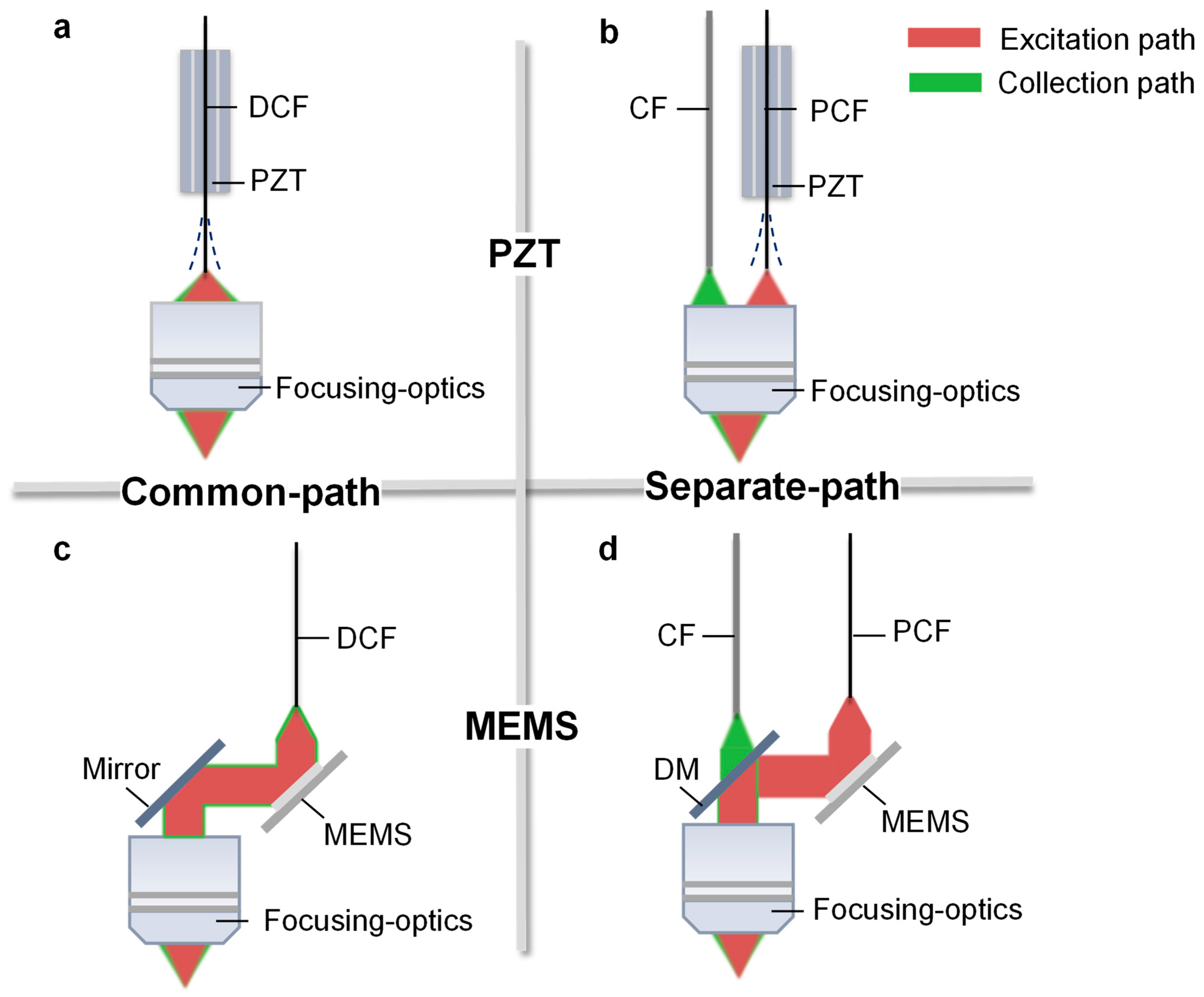
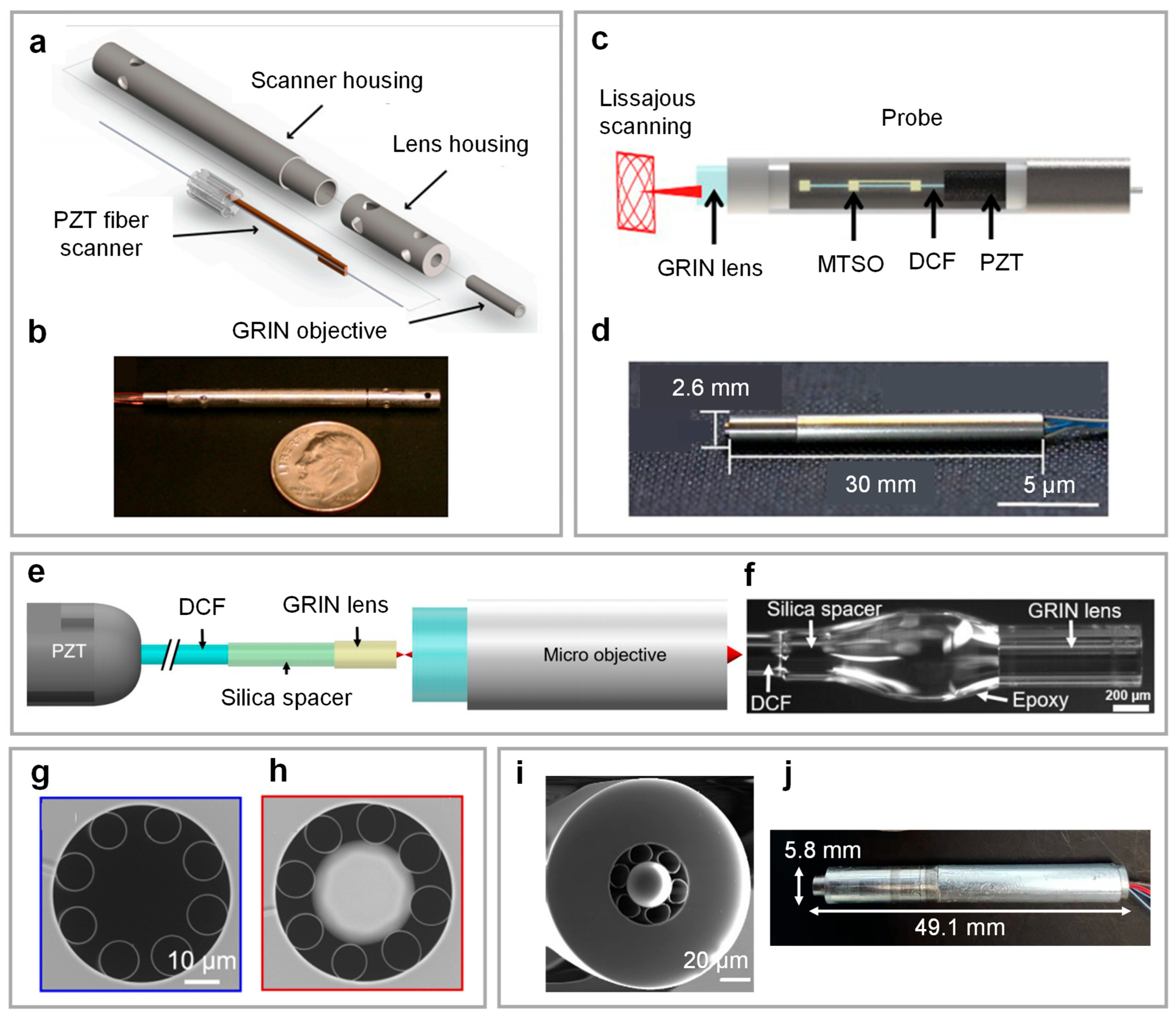
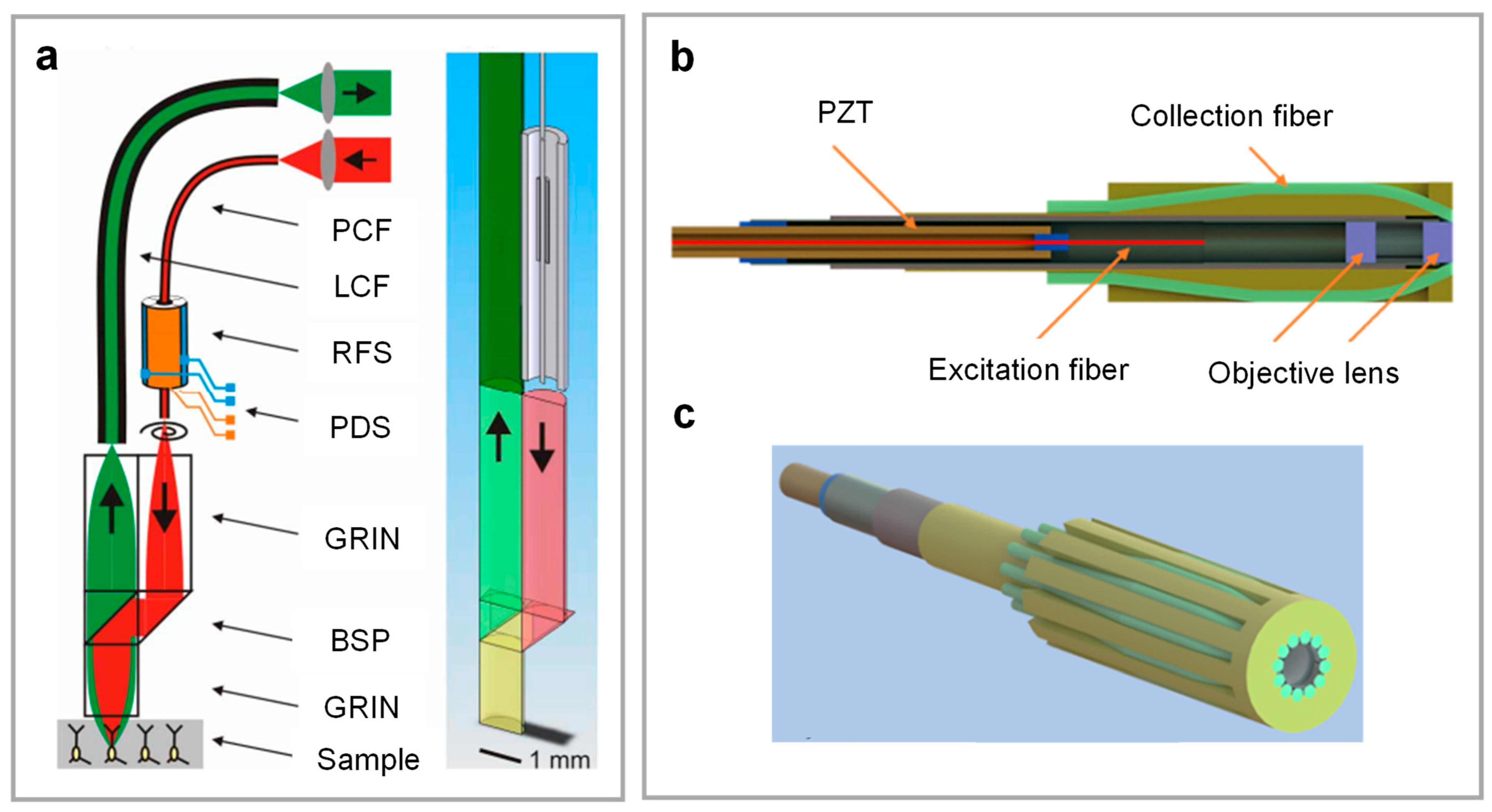
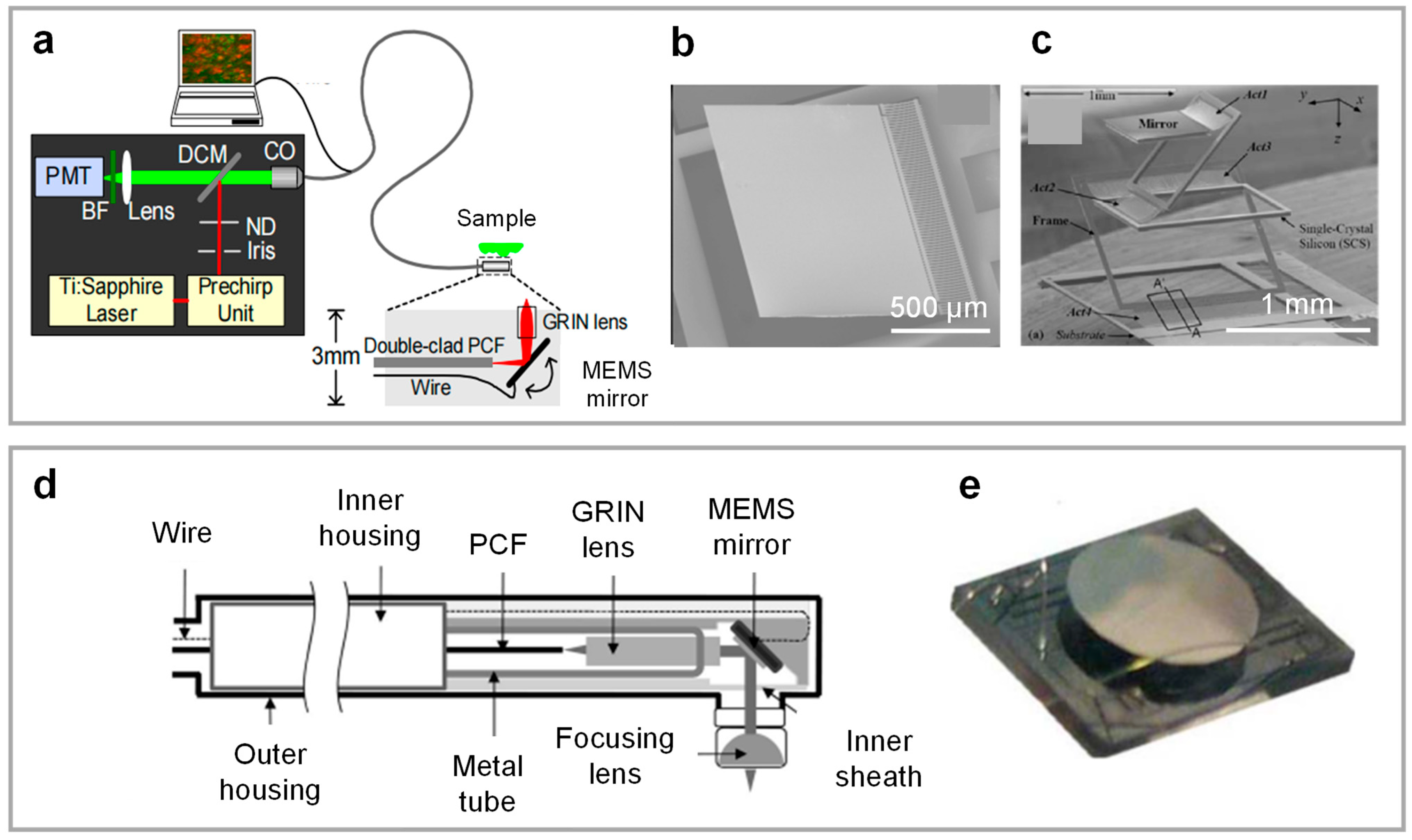
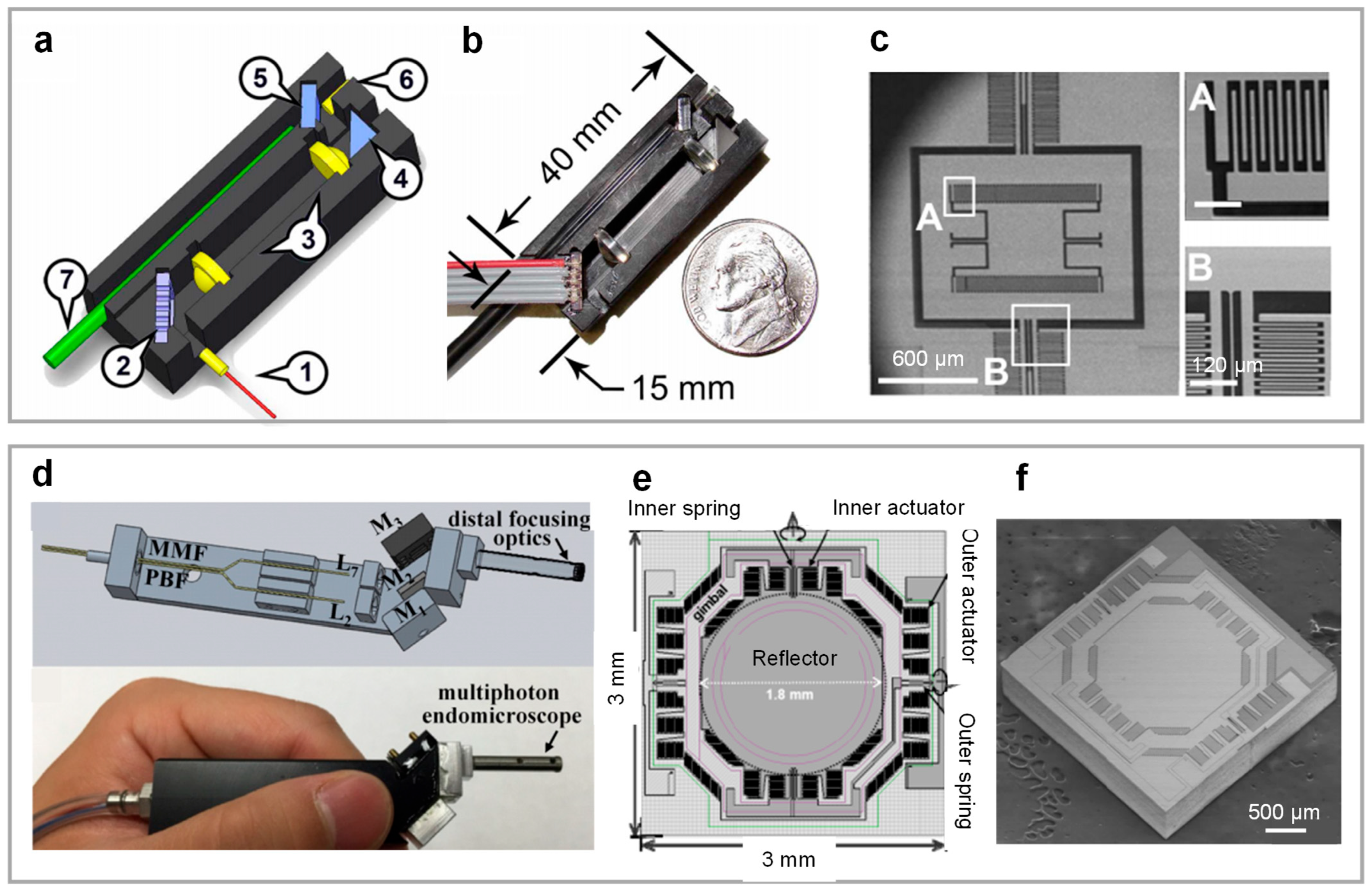

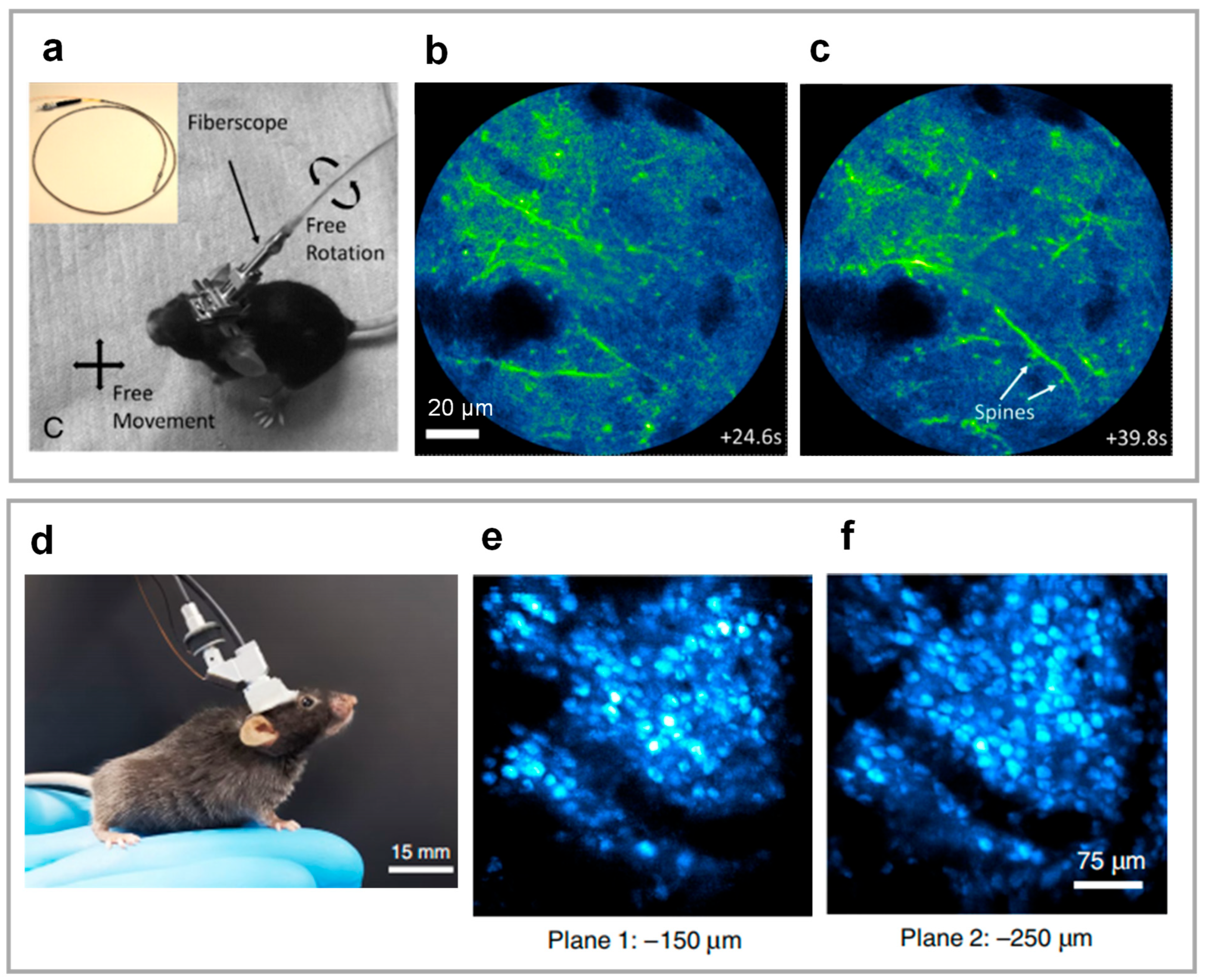
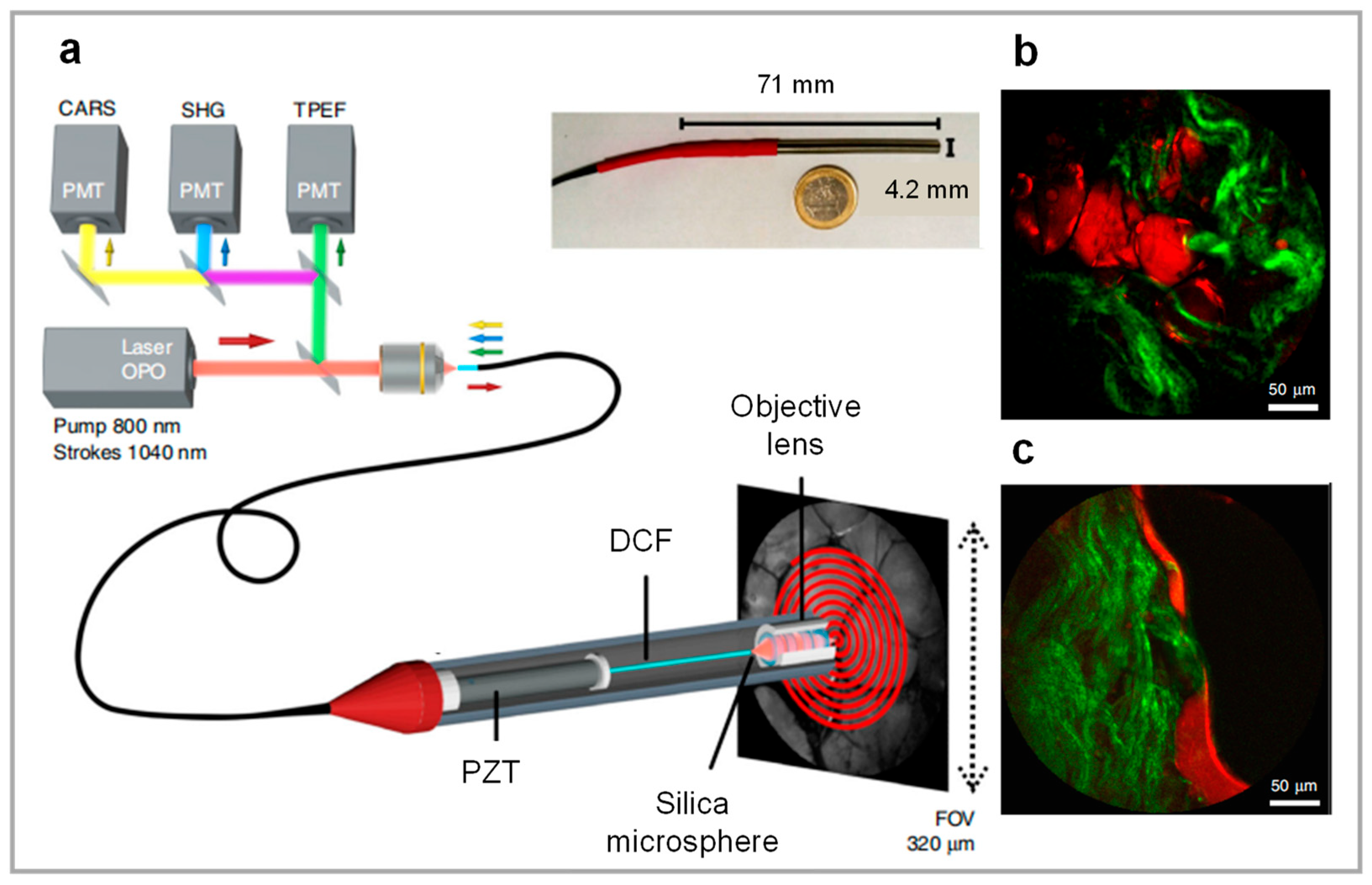
| Classification | Reference | Scanning Pattern | Scanning Frequency | Delivery Fiber | Resolution (μm) | FOV/(μm2) | Frame Rate (fps) | Outer Diameter (mm) | Rigid Length (mm) |
|---|---|---|---|---|---|---|---|---|---|
| PZT-based common-path | [31] | Raster | Fast: 1.05 kHz; Slow: 2 Hz | DCF | 0.8 | 110 × 110 | 4.1 | 3 | 40 |
| [32] | Spiral | 1.41 kHz | DC-PCF | 0.8 | 450 × 450 | 8 | 2.2 | 37 | |
| [33] | Spiral | 520 Hz | DC-PCF | 2.2 | 200 × 200 | 1.25 | 3.5 | 53 | |
| [6] | Spiral | ~1.4 kHz | DCF | 0.7 | 110 × 110 | 3 | 2 | 35 | |
| [34] | Lissajous | 885 Hz and 1160 Hz | DCF | 0.7 | 84 × 95 | 5 | 2.6 | 30 | |
| [36] | Spiral | Scanner 1: ~1 kHz; Scanner 2: ~3.1 kHz | DCF | 0.61 | 300 × 300; 160 × 160; | ~1.9 6 | / | / | |
| [38] | Spiral | 716 Hz | DC-ARF | 1.3 | 210 × 210 | 0.7 | 5.8 | 49.1 | |
| PZT-based separate-path | [41] | Spiral | ~5 kHz | PCF + LCF | 0.98 | 200 × 200 | 25 | / | / |
| [43] | Spiral | ~1 kHz | PCF + multimode fibers | 0.66 | 120 × 120 | 2 | 14.8 | / | |
| MEMS-based common-path | [46] | Raster | Fast: 64 Hz; Slow: 0.25 Hz | DC-PCF | 2 | 200 × 200 | 0.25 | 10 | 140 |
| MEMS-based separate-path | [49] | Lissajous | 1.54 kHz and 2.73 kHz | PCF + plastic optical fiber | 1.64 | 310 × 310 | 10 | / | 40 |
| [50] | Lissajous | ~2.91 kHz and ~805 Hz | PCF + MMF | 2.03 | 300 × 300 | 5 | 3 | / | |
| [52] | Raster | ~6 kHz | PCF + fiber bundles | 0.65 | 150 × 150 | 40 | >10 | / | |
| [53] | Raster | ~2.8 kHz | PCF + fiber bundles | 1.1 | 420 × 420 | 10 | >10 | / |
Disclaimer/Publisher’s Note: The statements, opinions and data contained in all publications are solely those of the individual author(s) and contributor(s) and not of MDPI and/or the editor(s). MDPI and/or the editor(s) disclaim responsibility for any injury to people or property resulting from any ideas, methods, instructions or products referred to in the content. |
© 2025 by the authors. Licensee MDPI, Basel, Switzerland. This article is an open access article distributed under the terms and conditions of the Creative Commons Attribution (CC BY) license (https://creativecommons.org/licenses/by/4.0/).
Share and Cite
Wang, C.; Yan, B.; Ma, S.; Li, H.; Feng, T.; Zhang, X.; Li, D.; Feng, L.; Wang, A. Advances in Distal-Scanning Two-Photon Endomicroscopy for Biomedical Imaging. Photonics 2025, 12, 546. https://doi.org/10.3390/photonics12060546
Wang C, Yan B, Ma S, Li H, Feng T, Zhang X, Li D, Feng L, Wang A. Advances in Distal-Scanning Two-Photon Endomicroscopy for Biomedical Imaging. Photonics. 2025; 12(6):546. https://doi.org/10.3390/photonics12060546
Chicago/Turabian StyleWang, Conghao, Biao Yan, Siyuan Ma, Haijun Li, Tianxuan Feng, Xiulei Zhang, Dawei Li, Lishuang Feng, and Aimin Wang. 2025. "Advances in Distal-Scanning Two-Photon Endomicroscopy for Biomedical Imaging" Photonics 12, no. 6: 546. https://doi.org/10.3390/photonics12060546
APA StyleWang, C., Yan, B., Ma, S., Li, H., Feng, T., Zhang, X., Li, D., Feng, L., & Wang, A. (2025). Advances in Distal-Scanning Two-Photon Endomicroscopy for Biomedical Imaging. Photonics, 12(6), 546. https://doi.org/10.3390/photonics12060546





